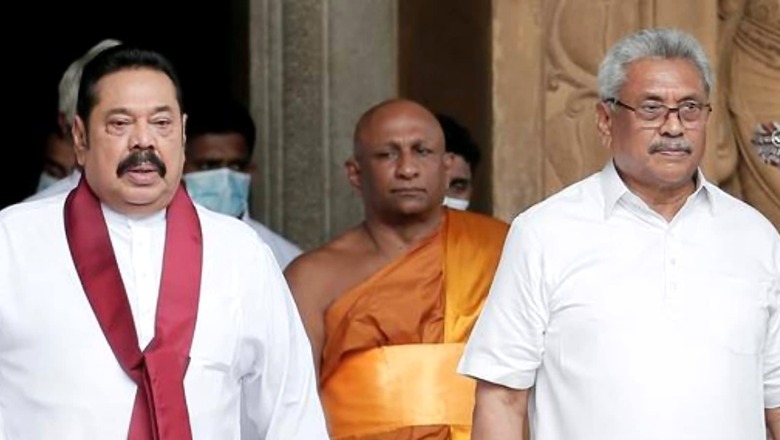
views
The horrific scenes emerging from Sri Lanka reached a crescendo in the past week. With the country declaring a state of emergency and the president tendering his resignation thereafter, protestors were seen going on a rampage and vandalising several buildings. The residences of many leaders were set ablaze, allegedly by the protesting mob. The president’s brother, a former president himself, and other family members, many of whom have held important posts in the country, have reportedly fled to a naval base. The protestors took to the streets many weeks ago as the country’s economic crisis worsened, and continued their agitation against the government. As the Sri Lankan central bank braces itself for what it describes as a total economic collapse, and with no leadership at the government’s helm of affairs, the country’s fate hangs in the balance.
Sri Lanka’s economic crisis is not an overnight phenomenon, nor is it one-dimensional. The country has incurred massive debts, borrowing steadily from international agencies, international markets, and of late, China, to finance various unnecessary or economically unviable projects. These loans have been restructured on many occasions in the past to avoid a balance of payment crisis, as servicing them would deplete the country’s foreign reserves. However, this is only the backdrop.
Also Read: Time’s Up For the Rajapaksas: Will the Family Fiefdom Outlast Sri Lanka’s Economic Mayhem?
Over the last two and a half years, at least four important factors have played a role in worsening the situation. First, right after Gotbaya Rajapaksa took over as president in 2019, he set out on an ill-advised tax-cutting spree. The move reduced the country’s tax base and tax revenue, as well as the government’s room to manoeuvre. Second, with the onset of the pandemic, the tourism sector came to a grinding halt. After the civil war ended more than ten years ago, the country emerged as one of the most sought-after tourist destinations in the world. The sector contributed to more than 12% of the GDP prior to the pandemic, and was the fifth-largest source of foreign reserves. It employed more than a million people. Third, in April last year, the government banned the import and usage of synthetic fertilisers and pesticides. The complete and instant shift to organic farming had devastating consequences for a country with an agrarian population of over 60%. Within six months, the domestic production of rice, the country’s staple food and a crop in which the country had achieved self-sufficiency, fell by 20%. The government was forced to import rice, and the prices went up by 50%. Moreover, the overnight organic shift damaged the country’s tea production massively. Tea was its primary export, and its largest source of foreign reserves. Lastly, the Russia-Ukraine conflict sent oil prices spiralling. All along, the government has printed more money, only worsening the inflation. This is the cocktail that resulted in the harrowing images coming out of Sri Lanka. The printing of money, the overnight shift to organic farming, and the tax cuts, are variables in this equation that the Rajapaksa government was responsible for. Perhaps, with more accountability, these measures could have been avoided.
Also Read: How a Meltdown in Sri Lanka Can Have Serious Implications for India’s Security
Back home in India, certain opposition politicians and eminent personalities predisposed to them, have chosen to draw rather bizarre lessons from the entire fiasco. They claim that majoritarian politics in Sri Lanka is what drove the country to the brink, and that if India were to continue going down the road of majoritarian politics, it too would face a similar fate as its Southern neighbor. In intellectual circles, the debate about whether India is actually heading down the road of majoritarian politics, is one that continues to rage and is far from being settled. Without even getting into this debate, the very premise of the argument – that it was indeed majoritarian politics that caused the crisis in Sri Lanka – is a flawed one. It is true that the wounds from the civil war are yet to heal, and that the country has seen a strong reaction to Islamic extremism after the Easter bombings of 2019. However, there is no evidence whatsoever to establish a link between these phenomena, the global or structural economic factors at play, or even the flawed economic measures adopted by the government.
If it is the opposition’s argument that the measures adopted by Gotabaya Rajapaksa’s government sent the economy into a tailspin, and that Gotabaya being in power is the result of majoritarian politics, it is a convenient framework to draw a parallel with the Modi government using a false analogy- that since a majoritarian government made bad economic decisions in one country, a majoritarian government in another will necessarily make the same bad choices. Not only are the scale and the context different for literally every parameter in India, but the entire argument hinges fully on the doubtful assumption that both governments are indeed majoritarian. This, though, is only one-half the story. The lesson that the opposition and its cronies have supposedly drawn is also a fig leaf. There are certain factors that arguably make the Indian opposition quite uncomfortable with the situation in Sri Lanka. The role that China played in pushing the country into a debt trap, or the role played by an Indian lobby in the country’s overnight shift to organic farming, known to be very close to the Indian left, are factors that the opposition has conspicuously avoided.
However, these factors do not compare to the elephant in the room, the one lesson that the opposition does not want India to draw from the Sri Lankan crisis, come what may. For years, Sri Lanka’s politics and government have been dominated by one family. The Rajapaksas, other than occupying the highest office of the land for a better part of the twenty-first century, have held important offices across the board, at various levels. The outgoing president Gotabaya Rajapaksa had served as the defense secretary in his brother and the then president Mahinda Rajapaksa’s administration after 2005. A third brother, Basil Rajapaksa, had served as the president’s advisor, and later, the economic development minister. A fourth brother, Chamal Rajapaksa, served as the speaker of Sri Lanka’s parliament after 2010. Mahinda’s son Namal was also elected to the parliament that year. At one time, due to the various positions held by different family members, the Rajapaksas controlled 70% of the country’s budget. Many members of the extended family also held key positions. After a surprise defeat in the 2015 elections, the family returned to power in 2019, with Gotabaya as president and Mahinda as Prime Minister.
The Indian opposition conveniently ignores these facts. The complete dominance by one family, resulting in a deficit of both talent and accountability, has brought about subpar decision-making. Populism, optics, personal interests, and whims, have driven the government to take several ill-advised measures. The consequences aside, this power dynamic is something the Indian opposition understands only too well. One family controlling the party, the government when in government, and various levers of power, is the model around which most prominent political parties in India have based themselves. Many of them, most glaringly at the national level, are out of power today. When the crisis in Sri Lanka is seen through this prism, a much more relevant prism than the majoritarian one, the case to keep such parties out of power only strengthens.
This is why the Indian opposition and dynasty historians are being patently dishonest in their analysis of Sri Lanka. The wood is being deliberately missed for the trees, because dynastic politics continues to remain their bread and butter.
Read all the Latest Opinions here




















Comments
0 comment